Canon EOS R5 Review
Canon EOS R5 Performance - How well does it take pictures?
Performance starts with image quality, which is the criteria used as the foundation of our digital camera ratings. Ergonomic issues may get in the way, but in the end, image quality counts the most. For an ILC, image quality greatly depends on the lens used. While color, noise, exposure and dynamic-range are properties of a camera, distortion, vignetting and chromatic aberrations are properties of the lens. Sharpness and contrast depend on the weakest link. That is, a camera cannot capture more details than a lens lets through. Conversely, it is quite possible for a lens to transmit more details than a sensor can capture.
Image Noise & Detail
The Canon EOS R5 sports a completely new high-resolution sensor with a unique design. This Full-Frame sensor is built of 90 million photosites, two per pixel, that share a color-filter yet measure light of different phase. The Color-Filter-Array over the sensor is a standard Bayer 2x2 block consisting of 2 green pixels, one red and one blue. Another filter splits light according to phase and a third provides a slight anti-alias effect. The circuit-density of this new sensor makes it difficult to achieve a wide dynamic-range which we analyze further down in this review. The anti-alias filter is an odd choice since it purposefully limits resolution and most high-resolution cameras forgo it now. It is often included in Video centric digital cameras though, since moire artifacts are much more problematic in video, hence this clarifies how Canon is positioning the R5.
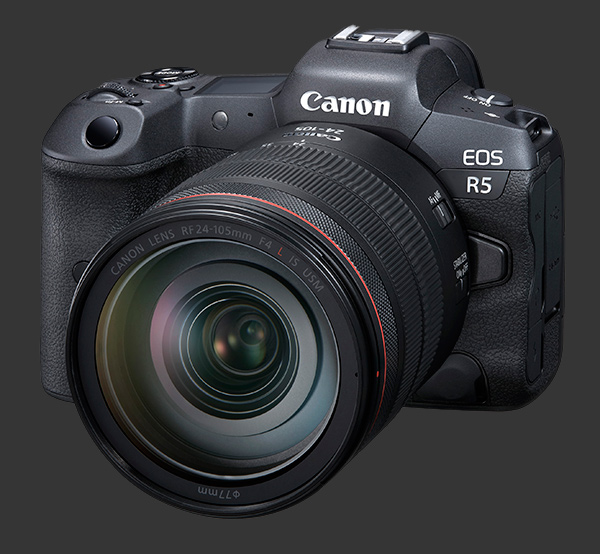
The 45 Megapixel Dual-Pixel AF II CMOS sensor from this mirrorless captures plenty of detail, although the effects of its anti-alias filter is evident upon close-inspection. The RAW output of the R5 is one the soft side and so requires more sharpening than other flagship cameras. Canon compensates for this by a sophisticated and highly-flexible sharpening filter with 3 parameters: Sharpness, Strength and Threshold.
The main Sharpness control is Strength, set on a scale from 0 to 7. It is the only parameter to control dial during video capture. The middle 3 level is reasonably sharp but 4 is crisper with no sharpening artifacts. For extra definition, setting Sharpness to 5 a good choice too. The Fineness parameter controls how edges are rendered by the sharpening filter. There are 5 levels to choose from with the first two being subtle and level 3 right on the edge of over-sharpening. Threshold holds back sharpening by setting a level below which less sharpening gets applied. This parameter also has 5 levels with zero representing smaller details. So, conversely to other Sharpness parameters, Threshold renders images more sharply at lower levels. The balance to strike it to find a level where noise does not get sharpened. At low ISO sensitivities, a Threshold of 2 is ideal but this should be raised for higher sensitivities.
With its unusually dense circuitry, the 45 megapixels CMOS sensor in the EOS R5 is produces higher image-noise than similar resolution sensors. This is immediately apparent when viewing images at 100%, even at its base ISO 100 sensitivity and Expanded Low ISO 50 setting. There is visible noise with a very fine pattern and is particularly noticeable in smooth areas. Canon offers 3 levels of builtin optional noise-reduction to combat the issue. The middle-level does a good job at balancing noise and detail overall but Low is preferable when capturing scenes within the ISO 100-400 range. Unfortunately, one can only set it to one level instead of one per ISO, so a compromise must taken.
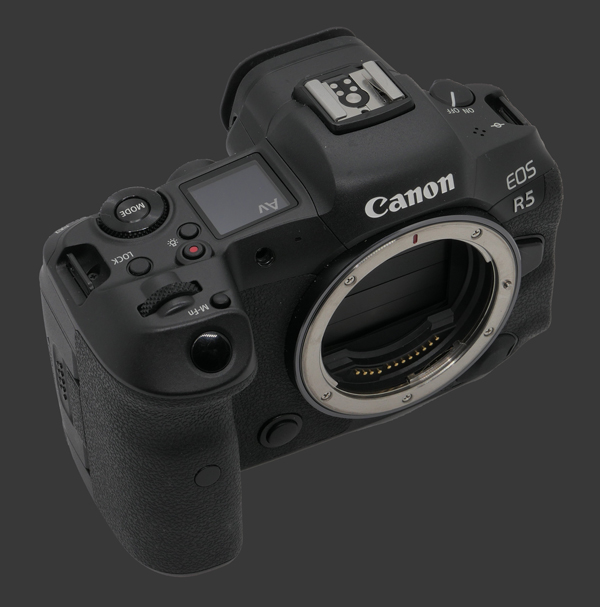
Images from the Canon R5 capture plenty of detail from ISO 50 to 6400. Noise is little impact on detail up to ISO 400 which is usable for large prints. Upon close inspection, there is also some visible noise which reduces maximum print sizes compared to expectations for a 45 MP sensor. Still, large 30" x 20" prints from the R5 look great at low ISO.
There is minor degradation of detail at ISO 800 and 1600. The finest wobble a bit while noise reduction mixes in unnaturally smooth patches, depending on the Threshold parameter. This minimally reduces potential print sizes. The ISO 3200 level is remarkably similar with just a tiny amount of extra detail lost. The trend continues at ISO 6400 which remains remarkably clean when Noise-Reduction is set to Standard.
All cameras become more noise at high sensitivities and the Canon EOS R5 is no exception. ISO 12800 shows a loss of fine detail and sharpness but the noise-reduction algorithm makes to make this mirrorless produce cleaner images than usual. For medium print sizes, the output looks exceptionally good. ISO 25600 is definitely soft from excessive noise-reduction required to smooth out noise which severely restricts potential print sizes. At that point, contrast starts become effected but colors remain remarkably uniform.
The last standard ISO 51200 level is very noisy and soft. It would work for small prints or web-use though as it produces images with a recognizable subject. The Expanded ISO 102,400 setting is a step further, to be reserved for emergency use only. An a small 4" x 6" photo, ISO 102400 remains clearly noisy but it is presentable as a souvenir.
Color & White-Balance
Color-rendition on the EOS R5 is controlled by a Picture Style, with 6 offering a difference balance of colors and saturation, and one monochrome mode. The output of any color Picture Style can be fine-tuned by Saturation and Color-Tone. Each is adjustable in 9 levels with fine steps. Both the Neutral and Faithful modes produce very natural colors, with Neutral being slightly undersaturated. There is tinge too much red by default in most styles but that is remedied by simply shifting Color-Tone to +1. A little does was it needed but users are free to make things more amber or blue for creative purposes. Using optimal settings, color accuracy is really good.
White-Balance settings are equally flexible. There are two Automatic White-Balance modes now. One is called Ambience-Priority and the other White-Priority. This is a common distinction between correcting some and all color-casts, as attempted by the latter. For the majority of scenes, the R5 does a great job, rendering neutral colors, even when light is dim. In night scenes dominated by artificial light, it can leave a slight yellow cast than can easily be corrected by one of the 6 presets available. There is also a Kelvin mode, plus Custom White-Balance. Canon requires a separate image to be captured to make the Custom WB reading rather than measuring on the spot. This is slightly less efficient yet rarely required.
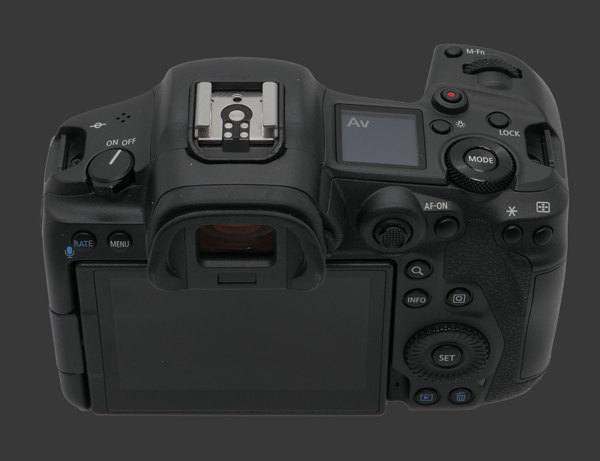
Exposure & Dynamic-Range
For years, Canon digital cameras were behind on both exposure and dynamic-range. Although not entirely related, it is easier to produce a good exposure when a camera has a wide dynamic-range. The R5 features the same 4 metering modes as other Canon Full-Frame models: Multi-Segment, Center-Weighed, Spot and Partial. The only sophisticated mode is Multi-Segment that measures brightness across 384 zones and weighs them according to their position relative to the focus-area.
Generally, this mirrorless produces fairly conservative exposures and rarely blows highlights. For scenes with very steep dynamic-range, the R5 offers Highlight Tone-Priority and Enhanced Highlight Tone-Priority modes. In this mode, the camera applies less gain to the sensor read-out which makes the base sensitivity shift to ISO 200, locking out ISO 50-100 and 102,400. This helps reduce clipping of highlight in the presence of shiny objects that produce highlights too small to be accounted for by any of the 384 metering-segments.
Multi-Segment metering is weighed somewhat strongly towards the focus-area, so there is a good chance of background over-exposure when capturing backlit subjects. In the opposite situation, when faced with a low-contrast scene. Images are rendered quite dimly which looses precision and shadow detail but this can easily be corrected with positive exposure-compensation. Canon shows a highly accurate preview which makes it easy to recognize when EC is needed. Center-Weighed and Spot metering modes work just as expected. The Canon-specific Partial mode is simply a larger Spot metering mode, using 6% of the frame instead of 3%.
Dynamic-Range from the R5 is vastly improved over previous Dual-Pixel AF sensors. For the fist time, this Canon camera can record over 14-stops of dynamic-range at its native ISO 100 sensitivity. This places it near the level of other high-resolution Full-Frame Digital Cameras. ISO 50 and 200 show virtually the same dynamic-range, also edging over the 14-stop mark. Dynamic-range naturally drops by one EV per stop of ISO, showing an excellent linear response from the R5 sensor. Impressively, this mirrorless maintains very stable colors and contrast throughout its sensitivity range.
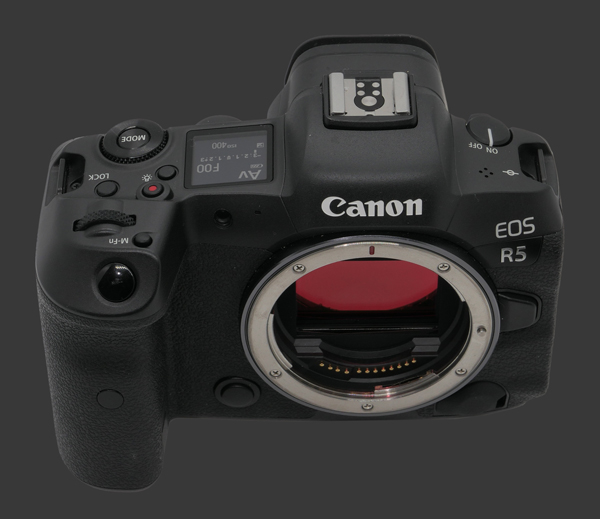
Autofocus
Seeing Canon innovate upon their already class-leading Dual-Pixel AF design is impressive. The new 45 megapixels CMOS sensor manages to focus anywhere in the frame with great precision and speed. The new Dual Pixel AF II system surpasses the tracking performance of its predecessor which let it follow subjects around the frame with minimal lag.
The Canon EOS R5 can focus decisively down to -6 EV at 5940 points or 1053 zones. These areas are made up of pixel clusters that measure phase data to determine in which direction the lens must change focus. The result is a system that avoids stuttering which is disruptive during video recording. It can drive a lens as fast as possible, leaving the lens to dictate the autofocus speed limit. Naturally, all RF lenses are designed for quick AF.
This mirrorless camera implements multiple tracking autofocus modes that can be fine-tuned for subjects that accelerate, move erratically or can momentarily pass behind another. It can automatically detect faces and eyes with priority given to humans or animal subjects. During the review, the R5 maintained subjects in focus exceedingly well.
Speed
The speed of the Canon EOS R5 is very impressive for a high-resolution model. This camera responds instantly to any dial turn and button press. It shoot quickly without delay and is ready for the next shot immediately after. There is virtually no shutter-lag and blackout is minimal with Instant Review disabled. When it is enabled, the captured image appears after a minimal pause of the display.
Continuous shooting with the R5 is very fast. In both 20 FPS Electronic-Shutter and 12 FPS Mechanical-Shutter modes, the camera maintains a fluid display with no blackout. The captured frame is used to fill the EVF while the shutter actuates which makes it easy to track moving subjects. Its deep buffer makes it possible to capture long bursts with CFExpress and slower SDXC memory-cards. When the buffer is full, it might take a few seconds to clear. This is much quicker with CFExpress compared to SDXC.
The performance of the Canon EOS R5 is characterized by these measurements:
- Power On: Under &1/2s. Very good.
- Power On to First-Shot: 1¼s Good.
- Autofocus: Shorter than ¼. Class-Leading!
- Shutter-Lag: None with almost no blackout. Excellent.
- Shot-to-Shot: 1/3s. Average. Stalls after 3 frames.
- Playback: Just below 1/2s. Average.
- Power-Off: 2s with Sensor-Cleaning, 1/2s without. Reasonable.
- Video Capture: Instant to start and stop. Perfect.
By any measure, this is a fast camera. It is exceptionally responsive and performs best in all important tests. The interface never slows down the photographers and the EVF keeps up with action even during continuous shooting. The surprising number is the 1/3s shot-to-shot speed that stalls after just 3 frames, despite the camera being able to shoot 20 frames continuously within the same interval! This is much of an issue since one can turn the camera offers 3, 6 and 12 FPS continuous shooting with a the mechanical-shutter plus 8 and 12 FPS with the electronic one.
Video capture happens instantly even at the maximum Cinema 8K resolution of 8192x4320 at 30 FPS. Recording stops immediately when the record button is pressed again. More details below in the Video section of this in-depth Canon EOS R5 review.
A relatively large proprietary Lithium-Ion battery gives the R5 320 shots-per-charge battery-life. This is about 10% below average for a modern mirrorless but not surprising considering how much processing power it needs to process data from 90 million photosites 20 times per second! Getting an extra pair of batteries is highly recommended for a full day of photography.
Canon EOS R5 Performance - How well does it shoot video?
The launch of the Canon EOS R5 introduced the first digital camera capable of capturing 8K video. This achievement for video, along with the class-leading 5-axis builtin image-stabilization system, propelled the R5 ahead of every other offering. 8K offers a substantial increase in video resolution over 4K which turned mainstream in just the last few years.
Television resolution are typically measured by the number of lines in each frame. When HD was introduced video was standardized to a wide 16:9 aspect-ratio with two high-definition resolution: HD and Full HD, respectively offering 720 and 1080 lines. This was a substantial leap from previous analog signals containing between 480 and 525 lines, depending on the region. At some point, the naming convention switched from lines or columns which allows to differentiate between various aspect-ratios. Given that Full HD is recorded at 1920x1080, it is almost 2000 pixel wide and a slightly wider 2K format was introduced with same number of lines: 2048x1080 having a 17:9 aspect-ratio.
Ultra-HD quadruples the HD resolution by doubling the number of lines and columns to 3840x2160 at 16:9 for 4K and 4096x2160 at 17:9 for Cinema 4K. This is yet another leap beyond Full HD that can only be appreciate with larger televisions. The human eye is physically unable to resolve beyond Full HD when the image spans less than 30° of the visual field-of-view and requires 60° to fully distinguish between 4K pixels. Multiplying out its dimensions, 4K is made of roughly 8 MP frames that must be cropped out of a 12 MP camera sensor due to the difference in aspect-ratio.
8K is the newest resolution which also the quadruple of 4K or 16X Full HD! Doubling horizontal and vertical resolution, 8K video is made up of 7680x4320 pixels for standard 8K and 8192x4320 for Cinema 8K. Capturing frames of such high-resolution requires a 45 megapixels sensor. The Canon EOS R5 is among a handful of digital cameras having enough resolution for 8K. This being video, it also takes a huge throughput to continuously read 45 MP frames at at least 24 FPS. In fact, the Canon EOS R5 can record Cinema 8K @ 30 FPS which requires processing 1.5 billion pixels-per-second!
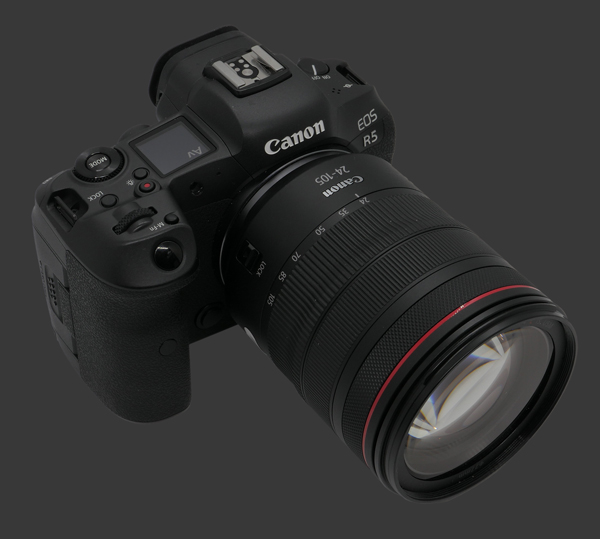
Video quality from the Canon R5 is absolutely spectacular. The amount of detail captured in 8K video is incredibly high. There are very few ways to see this detail. The easiest of simply an 8K TV and being sufficiently close that it spans 120° of your field-of-vision. There are several models on the market and they all cost at least as much as the R5 itself. The other is to use a 4K or smaller portion of each frame to digitally zoom within an 8K video. Since there are no Cinema 8K televisions or monitors, this is the only current option to use such video. In an incredible feat of performance, the R5 can record Cinema 8K in 12-bit RAW.
Naturally, with the ability to capture 8K, the EOS R5 is capable of recording 4K with easy. It supports 10-bit output and up to 120 FPS with All-Intra encoding for incredible detail and ultra-smooth motion. More conventional 30 and 60 FPS modes are also available in both 4K and Cinema 4K. Video files record scenes with life-like detail.
Capturing video at such high resolution and frame-rate requires a huge amount of bandwidth, power and storage which is why there are shorter limits than with less demanding formats. Canon specifies a maximum recording time of 20 mins per 8K video but that is for ideal laboratory conditions. For practical applications, the limit is between 5 and 10 minutes, depending on the ambient temperature and air-flow around the camera.
4K video can be recorded for longer. At 60 FPS or higher, the hard-limit is 25 minutes yet 15 is probably more typical. Switching to 4K at 30 FPS, there is no limit to how long the R5 can record, although individual video files are restricted to one second under 30 minutes. Another video can be recorded immediately after in this mode, while recording at higher resolution requires a cool-down period before each new capture.
Interestingly, the Canon EOS R5 is capable of generating 8K Time-Lapse without limit since the throughput required is much lower and the sensor does not overheat given there is at least one second between frames. As that is not considered filming, there is no arbitrary 30 minutes limit either.
This camera is highly-responsive in video mode. Video record starts and stops immediately upon pressing the Video Record button. The Dual Pixel AF II system is capable of smoothly tracking subjects as they moving within the frame. All autofocus modes are available while recording, include face and eye tracking. As one would expect, the resulting video files is proportional to resolution and frame-rate. Each minute of 8K video requires between 4.8 and 18 GB. 4K videos need between 1.2 and 14 GB per minute. This directly correlates to the minimum required write speed of the memory-card in use. Remember that most cards advertise their maximum read speed and so one must check specifications to figure out the supported write speed.
Canon EOS R5 Conclusion
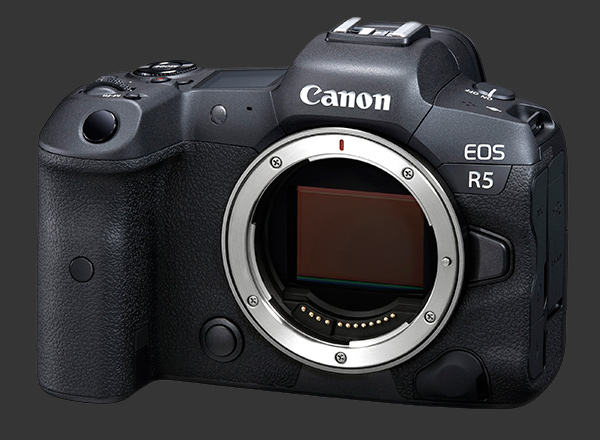
The new Canon EOS R5 exceeds the lofty expectations set by its class-leading specifications. This mirrorless flagship delivers image-quality that is beyond any previous Canon DSLR and mirrorless digital camera. Its 45 megapixels Dual-Pixel AF II Full-Frame CMOS sensor offers nearly the same resolution as the Canon EOS 5DS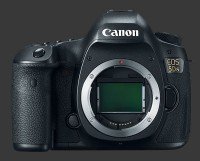
Canon EOS 5DS while being 3-stops more sensitive and capable of capturing that much more dynamic-range. It gives up fractionally on detail by using an anti-alias filter and stepping back slightly in terms of absolute resolution but it more than makes up for it by improving color, contrast, white-balance and metering.
Photos from the high-resolution R5 show plenty of detail with really good color accuracy and balance. Noise level is a little higher than expected from a 45 MP sensor due to the minuscule photosites of its Dual-Pixel AF II sensor. This means a slight reduction of potential print-size but it can still print larger than an Canon camera except the 5DS. Noise remains well controlled until mid-range sensitivities with an effective noise-reduction filter that keeps output usable throughout the entire Canon R5 standard sensitivity range. Expect all common print-sizes to look good until ISO 6400.
Dynamic-Range from the R5 is comparable to other flagship mirrorless digital cameras. It can capture 14-stops from ISO 50 to 200 with a standard linear-drop thereafter. Contrast follows dynamic-range and is well-maintained until ISO 12800. Colors stay remarkably consistent even at maximum sensitivity. This wide dynamic-range helps the Canon R5 meter reliably. Highlights are very rarely over-exposed but low-contrast scenes are helped by positive Exposure-Compensation.
The first IBIS from Canon that debuted in the R5 is significantly ahead of the competition. With a CIPA rating of 8-stops, this state-of-the-art 5-axis image-stabilization system delivers above 5 stops in real-world use. This makes it possible to photograph at lower ISO hand-held with the R5 than other digital cameras. Along with this stabilization mechanism, the R5 brings in an outstanding number of features, including 7-Frame AEB, WB Bracketing, Focus Bracketing, an Interval-Timer, Multiple Exposure and much more.
Canon made the R5 their most efficient camera to operate while maintaining a relatively compact form-factor in a weatherproof body. Its superb 5.8 MP 0.5" EVF with large 0.76X magnification, 100% coverage and Eye-Start Sensor provides the most accurate preview among current digital cameras. Having triple control-dials and an 8-way joystick provides direct controls over all exposure parameters and focus selection. The new Dual-Pixel AF II technology allows precise autofocus with tracking anywhere within the frame. Autofocus is very fast and sensitive in extremely-low light.
It is impossible to discuss the Canon EOS R5 without its ground-breaking 8K video capability. Videos recorded in 8K have an incredible level of detail that few people can see. It is a technological demonstration that pushes the limits of what the camera can handle. The R5 can record short 8K clips which provides it excess power to handle 4K video with outstanding results. While its video feature-set is rich, Canon made very little compromise on photography, except for the use of a rotating display rather than a more practical tiling model.
Owners of Canon DSLRs looking towards mirrorless are going to want the R5 or the similar R6. Both cameras can use existing EF-mount lenses via an adapter that retains all lens features while adding image-stabilization! The main choice becomes between the higher 45 MP resolution of the R5 versus 20 MP on the more-affordable R6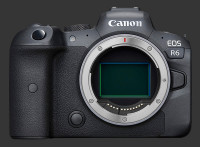
Canon EOS R6 which is more sensitivity to light but lacks 8K video and uses a lower-resolution EVF.
 |
Please Support Neocamera
All information on Neocamera is provided free of charge yet running this website is a huge endeavor. Purchases made via affiliate links found throughout the site help keep it running and up-to-date. There is no additional cost to you, so please consider buying via these links to our affilates:
If you found any information on this site valuable and did not purchase via our affiliate links, please considering donating via PayPal:
Any amount will be greatly appreaciated. Thank you for your support!
Canon R5 Highlights
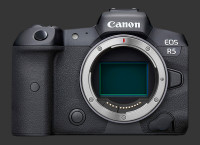
Sensor-Size: 36 x 24mm

Actual size when viewed at 100 DPI
| 45 Megapixels Mirrorless | ISO 50-102400 |
| Canon RF Mount 1X FLM | Shutter 1/8000-30s |
| 5-Axis Built-in Stabilization, 8-Stop Improvement | Full manual controls, including Manual Focus |
| 0.50" Built-in EVF 5.8 Megapixels (0.76X) | Custom white-balance with 2 axis fine-tuning |
| Automatic Eye-Start sensor | Spot-Metering |
| 2 Axis Digital Level | Hot-Shoe |
| Weatherproof | Stereo audio input |
| Built-in Dust Reduction | Lithium-Ion Battery |
| 20 FPS Drive, 170 Images | CF Express Type B, Secure Digital Extended Capacity |
| 8192x4320 @ 30 FPS Video Recording | |
| 3.2" LCD 2.1 Megapixels |
Updates
2024.04.03

Fujifilm X-T5 Review
Newest Fujifilm flagship boasting a 40 MP APS-C sensor, 5-axis IBIS with 7-stop efficiency, 15 FPS continuous drive, 6.2K Video capture, dual control-dials and dual SDXC UHS-II slots in a sturdy weatherproof and freezeproof body.
2023.11.20

Best Digital Cameras of 2023
Find out which are the Best Digital Cameras of 2023. All the new Mirrorless Digital Cameras from entry-level to high-end professional.
2023.07.10

Fujifilm X-H2 Review
40 Megapixels APS-C Hybrid Mirrorless Digital Camera with 7-stop IBIS. Fastest shutter ever and 8K video capture. Large builtin EVF with 0.8X magnification and 5.8 MP, plus an Eye-Start Sensor. Packed with features and large number of controls in a weatherproof and freezeproof body.
2023.05.07

Sony FE 20-70mm F/4G Review
Review of the unique Sony FE 20-70mm F/4G lens. The optical zoom of this lens spans ultra-wide-angle and medium focal-length coverage, making it one of the most versatile Full-Frame lenses on the market.
2023.01.15

Huion Inspiroy Dial 2 Review
Review of the Huion Inspiroy Dial 2 tablet, a medium sized drawing surface with dual dials and customizable buttons. Connects via USB-C or Bluetooth 5.0 with Windows, Linux and Android support.
2022.12.08

How to Pack for a Photo Trip
Find out how to pack for a travel photography trip, carry your gear safely while meeting airline regulations.
2022.11.13

Best Digital Cameras of 2022
The best digital cameras of 2022. A short list of the most outstanding models in their respective categories. Choose one for yourself or as a gift.
2022.09.21

Pentax DA* 60-250mm F/4 SDM Review
Review of the Pentax DA* 60-250mm F/4 SDM, the constant-aperture telephoto zoom with the highest zoom-ratio on the market.
2022.09.20

Pentax DA* 50-135mm F/2.8 SDM Review
Review of the Pentax DA* 50-135mm F/2.8 SDM, the lightest professional telephoto zoom native to the K-mount.
2022.09.10

Pentax DA* 11-18mm F/2.8 DC AW Review
Review of the Pentax DA* 11-18mm F/2.8 DC AW, the widest professional ultra-wide zoom native to the K-mount.
2021.11.24

50 Gifts Under $50 For Photographers in 2021
50 Gifts photographers will love. All for under $50 USD. 2021 Edition.
2021.11.17

Best Digital Cameras for 2021
Neocamera shows which are the very best Digital Cameras for 2021 in every category: Mirrorless, DSLR, Premium Compact, Ultra-Zoom and Rugged.











